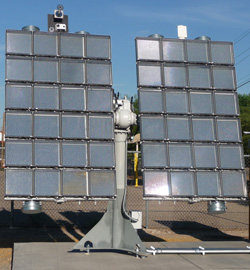- News
8 December 2010
Semprius installs demo microcell-based HCPV system at Tucson Electric Power
 Semprius Inc of Durham, NC, USA, which develops high-concentration photovoltaic (HCPV) panels, has installed what us says is the industry’s first microcell-based HCPV research development & demonstration (RD&D) system.
Semprius Inc of Durham, NC, USA, which develops high-concentration photovoltaic (HCPV) panels, has installed what us says is the industry’s first microcell-based HCPV research development & demonstration (RD&D) system.
Deployed in August at UniSource Energy Corp subsidiary Tucson Electric Power (TEP) — which provides power to more than 400,000 customers in southern Arizona — the system combines Semprius’ high-efficiency HCPV modules with a highly optimized, automated solar tracking system developed by Siemens. The TEP project is part of a joint development agreement signed in January by Semprius and Atlanta-based Siemens Industry Inc (the US affiliate of Siemens’ global Industry Sector business) that will result in the deployment of numerous HCPV systems at test sites around the world.
Picture: Semprius RDD system at TEP.
Siemens supplied the RD&D system's two-axis tracker, which uses Siemens’ Simatic S7-1200 automation system and the Solar Positioning Algorithm of the US National Renewable Energy Laboratory (NREL), which provides a tracking accuracy of better than 0.2º. The Siemens industrial electronics components are designed to operate in Arizona’s arid desert climate. The tracker also features built-in remote data acquisition capability that allows Semprius to monitor the performance of the system.
“Competitive project deployment cost for HCPV will be the key for the success of this technology,” notes Peter Krause, business segment manager for Siemens Industry Inc. “By combining our advanced automation and control equipment with Semprius HCPV panel, we believe this project will demonstrate the technology’s potential to deliver grid-level prices to utility customers,” he adds.
Semprius says that HCPV offers the lowest solar levelized cost of energy in sunny, dry climates of any photovoltaic technology by providing higher conversion efficiency and higher energy yield. Using a patented production process, the firm has developed microcells that increase system performance and reliability and decrease cost. The high-efficiency gallium arsenide-based microcells, measuring just 600μm by 600μm in area and less than 10μm thick, are up to 300 times smaller than cells used by competing HCPV manufacturers, it is claimed. Optics concentrates the sunlight 1000 times so that just 0.1% of the module area is covered with the microcells. The microcell’s very small size enables use of low-cost optics and electrical interconnects, which remove the heat, eliminating the need for costly thermal management solutions.
“Our technology’s extremely small footprint and high efficiency play a key role in minimizing HCPV system cost and improving performance and reliability,” says president & CEO Joe Carr. “This demonstration system will represent a major step forward in the continuing effort to drive down the cost of solar power,” he believes.
“We’re looking forward to learning how Semprius’ HCPV technology performs in our service territory, particularly during periods of peak electric usage,” says Steve Metzger, TEP's superintendent of distribution planning & technical services. “This collaborative project will contribute significantly to our efforts to evaluate and improve the performance of solar technologies employed by TEP customers.”
